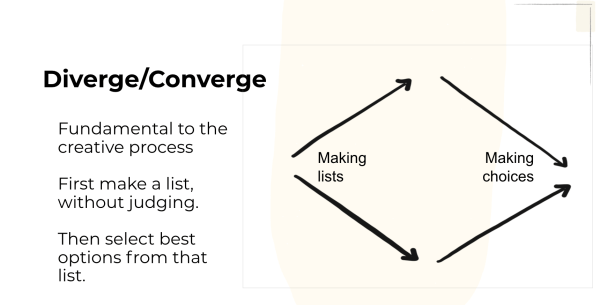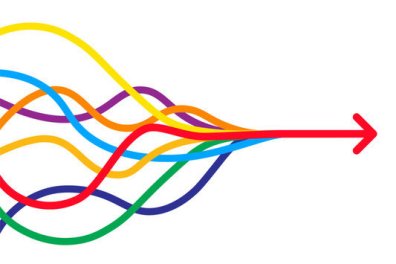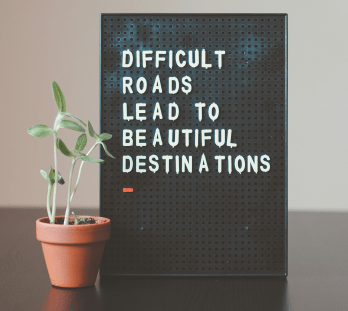Choosing is Hard: Why Convergence Is Difficult
- Inclusive Innovation

- Jun 19, 2024
- 5 min read
The creative process is a continual interplay of divergent and convergent thinking: making lists and making choices. Divergence involves generating a multitude of options by suspending judgment to encourage a flow of creativity. This phase is relatively straightforward; it taps into the limitless nature of imagination and brainstorming. It gets trickier when it’s time to converge and make choices, when the options generated must be filtered, refined, and ultimately, selected.
The Fundamental Dynamic of Diverge/Converge

Divergence is about expansion—creating a wide array of options without immediate evaluation. This leverages creativity, encouraging participants to think laterally and to explore unconventional ideas. We challenge participants to make a long list of options; the goal is to reach the “third third” of ideas where the most novel and innovative concepts emerge. In contrast, convergence is about contraction—narrowing down these options to identify the most viable and promising ones. This requires a different set of cognitive skills, including analysis, critical thinking, and decision-making. And somehow, it always seems harder.
Why Convergence is Difficult
Emotional Attachment
One barrier is the emotional attachment we develop to our own ideas. During the divergent phase, people invest time, energy, and personal creativity into generating options. When it comes time to evaluate so many of these ideas, it can be difficult to remain objective. Emotional biases can cloud judgment, leading to a reluctance to eliminate certain options.

Fear of Missing Out
The fear of missing out (FOMO) on potentially groundbreaking ideas can hinder convergence. In the face of numerous possibilities, there is an inherent anxiety that discarding any option might lead to the loss of a potentially brilliant solution. This fear can paralyze decision-making, making it challenging to commit to a particular direction.
Cognitive Overload
If we’ve generated a good long list – and we typically try to – there’s a lot to sort through. Convergence requires synthesizing and evaluating a large amount of information. This cognitive demand can lead to overload, where the sheer volume of options makes it difficult to process and prioritize effectively. The mental effort required to compare and contrast various ideas can result in decision fatigue, causing us to either procrastinate or make suboptimal choices. Unfortunately converging activities often fall at the end of the day in an agenda, when people’s brains are already taxed. We try to avoid that, sometimes leaving the ideas to simmer overnight so people can make choices in the morning when they are fresh.
Group Dynamics
In collaborative settings, group dynamics can absolutely impact the convergence process. Differing opinions, power dynamics, and communication styles can complicate the process of reaching a consensus. Dominant voices may overshadow quieter but equally valuable perspectives, leading to a skewed selection of ideas. It’s critical to use deliberate convergence tools create a level playing field among the group.
Complex Problems
Converging can be particularly sticky, for instance when we’re working on challenges in the development sector. The range of pressing issues—from poverty alleviation and healthcare to education and disaster response— is characterized by complex, interdependent problems that often require holistic solutions. Professionals in this field are acutely aware of the interconnectedness of social, economic, and environmental issues, making it challenging to prioritize one problem or idea over another. The urgency and importance of various issues can create a sense of responsibility to tackle as many problems as possible, leading to resistance against prioritizing and narrowing down options. This desire to do it all can result in a paralysis of decision-making, where the fear of neglecting any vital issue hinders the ability to converge on a focused strategy.
Making Convergence Easier

To start, it’s key to adopt the right mindset: we are making choices to move forward, and often this means narrowing the focus and addressing one challenge at a time, or developing an incremental solution. But we are never discarding options – just selecting those to work with first. We can always return to the original list of ideas and revive those not initially selected. (That’s one of the reasons we use Post-it notes. We never cross anything out; we just move the most useful Post-its to the next flipchart page.)
Structured Decision-Making Frameworks
There are a number of structured tools that guide people through a deliberate evaluation process, step-by-step. For instance, once we’ve made a list of challenges, we have a tool called the 4 “I”s, which systematically helps groups (and individuals) sift through a number of potential problem statements and select one that will yield the most useful ideas. We also have a tool called PPCO, which we use to strengthen ideas as we evaluate them, helping to make better choices. Other tools such as the SWOT analysis, or using a weighted criteria matrix offer systematic approaches to evaluate and prioritize ideas. These frameworks help break down the decision-making process into manageable steps, reducing cognitive load and ensuring a more balanced evaluation.
Establish Clear Prioritization Criteria
Sometimes the choices are obvious, but usually it’s hard to see which options will have the most impact. This is when we advise groups to set aside the list of options, momentarily, and take time to develop clear, objective criteria for evaluating and prioritizing challenges and ideas. These criteria might include potential impact, feasibility, resource availability, alignment with organizational goals, and sustainability. By focusing on these metrics, individuals and groups can more objectively assess the merits of each option. (It’s worth noting that we try not to emphasize the criteria too heavily before generating options, as it can limit a groups’ thinking during the moments that they are meant to think expansively.)
Iterative Convergence
Instead of attempting to converge in a single step, adopting a phased approach can be effective. Start with a round of sense-making, which includes clustering similar options into categories or families, to review the landscape before making selections. Sometimes we organize ideas by their flavor: mild, medium or spicy. This helps us to consider the level of novelty or risk before we make choices. Or we can use a value/doability matrix (also called ease/impact matrix) to organize the ideas, after which a deliberate decision can be made to pursue high-value ideas along the range of feasibility. Once this sensemaking has occurred – often the visual comparison of options is useful – it can be easier to make informed choices about how to move forward.
Iterative convergence involves multiple rounds of evaluation and refinement, gradually narrowing down the options. This approach allows for continuous feedback and adjustment, ensuring that the most promising options are selected, and even improved over time.
Encouraging a Growth Mindset
Fostering a growth mindset within the team can alleviate the emotional challenges associated with convergence. Encouraging individuals to view the convergence process as an opportunity for learning and development rather than a win/lose scenario can reduce attachment to specific ideas. Emphasizing the value of the collective creative process over individual contributions can help shift focus from personal ownership to collaborative success.
The convergence phase of the creative process is inherently challenging; it’s hard to choose among a wide field of potential options. But by using structured decision-making tools, criteria-based evaluation, iterative convergence, and fostering a growth mindset, individuals and groups can navigate this phase more comfortably. Deliberate convergence is critical to the creative process; that’s how we make sure that the most innovative and viable ideas are brought to fruition.
Go Futher: Going beyond the basics of divergent and convergent thinking, framing convergence as part of the yin-yang of creativity, finding the balance between diverging and converging.




Comments